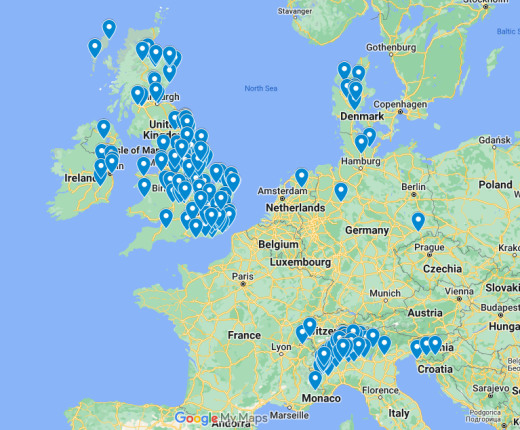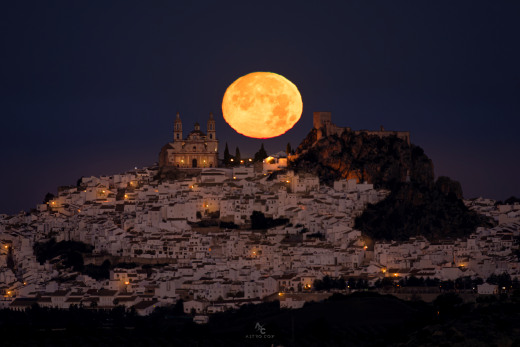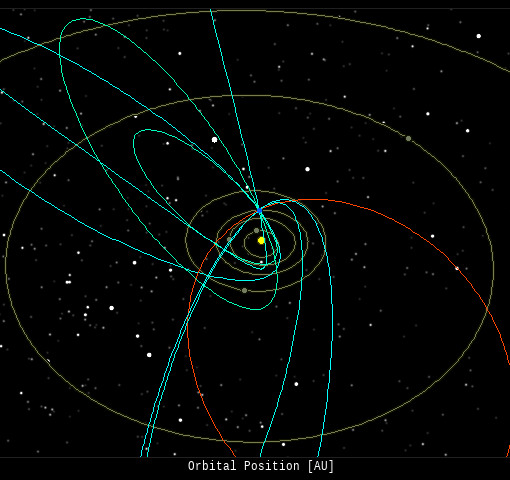This is an AI Free Zone! Text created by ChatGPT and other Large Language Models is spreading rapidly across the Internet. It's well-written, artificial, frequently inaccurate. If you find a mistake on Spaceweather.com, rest assured it was made by a real human being. | | |
GEOMAGNETIC STORM WATCH--CANCELED: A CME expected to graze Earth on Dec. 27th has not arrived. Either it missed or it is moving more slowly than expected. Either way, the chances of a geomagnetic storm today have subsided. Maybe next time! CME impact alerts: SMS Text
WIDESPREAD POLAR STRATOSPHERIC CLOUDS: Last week, Dec. 17th-24th, temperatures in the Arctic stratosphere dipped to a 40-year low. The result was a widespread outburst of polar stratospheric clouds (PSCs). Normally confined inside the Arctic circle, the aurora-like clouds descended all the way to Italy and the south of France:

Spaceweather.com reader Jamie McBean created this map of sightings drawing on a variety of sources: "I used the SpaceWeather Photo Gallery, Twitter, Facebook and other forums such as Netweather for the UK and 3BMeteo for most of the sightings from Italy," says McBean.
" I've almost certainly missed out on some locations as I can't have scoured *everything,*" says McBean. "For example, you can see that with big gaps in Germany. Cloud cover has been pretty extensive in NW Europe recently, so I am sure more locations would have seen these amazing clouds if not."
The outburst is over--for now. PSCs typically appear two or three times every winter in response to cold waves in the stratosphere. If this first apparition is a sign of outbursts to come, we could be in for a great season. Stay tuned.
Realtime Space Weather Photo Gallery
Free: Spaceweather.com Newsletter
THE COLD MOON SETS: Last night's Full Moon was the final Full Moon of 2023. Astrophotographer Jordi Coy spent months planning this farwell shot:

"I photographed the Moon setting behind the mystical village of Olvera in Cádiz, Spain," says Coy. "To get this photograph I had to move 5.7 kilometers away from the village. It was a difficult job to find the exact place to align the Moon with the village, the terrain is very hilly and getting a clean place took me months of searching, but I finally found it."
"Olvera is one of the most beautiful villages in Spain," adds Coy. "It belongs to the World Heritage Site and the so-called white villages of Andalusia, for having all its houses painted in lime. The reason for whitewashing their houses dates back to the time of the Roman Empire to protect them from epidemics."
Realtime Full Moon Photo Gallery
Free: Spaceweather.com Newsletter
AMBER DRAGONFLY SPACE PENDANT: This dragonfly has touched space. On Nov. 28th, the students of Earth to Sky Calculus launched it to the stratosphere onboard a cosmic ray research balloon, 109,228 feet above California's Sierra Nevada:

You can have it for $179.95. Made of genuine Baltic Amber with a sterling silver exoskeleton, the pendant measures 1 1/4 inch and comes with a matching 18-inch sterling silver chain. The wings of the dragonfly include four pieces of natural amber colored Cognac, Olive Green and Honey Yellow.
The students are selling space pendants to pay the helium bill for their cosmic ray ballooning program. Each one comes with a greeting card showing the jewelry in flight and telling the story of its trip to the stratosphere and back again.
Far Out Gifts: Earth to Sky Store
All sales support hands-on STEM education
Realtime Aurora Photo Gallery
Free: Spaceweather.com Newsletter
Realtime Comet Photo Gallery
Free: Spaceweather.com Newsletter
Every night, a network of
NASA all-sky cameras scans the skies above the United States for meteoritic fireballs. Automated software maintained by NASA's Meteoroid Environment Office calculates their orbits, velocity, penetration depth in Earth's atmosphere and many other characteristics. Daily results are presented here on Spaceweather.com.
On Dec 26, 2023, the network reported 7 fireballs.
(5 sporadics, 2 December Leonis Minorids)

In this diagram of the inner solar system, all of the fireball orbits intersect at a single point--Earth. The orbits are color-coded by velocity, from slow (red) to fast (blue). [Larger image] [movies]
Potentially Hazardous Asteroids (
PHAs) are space rocks larger than approximately 100m that can come closer to Earth than 0.05 AU. None of the known PHAs is on a collision course with our planet, although astronomers are finding
new ones all the time.
On December 27, 2023 there were 2349 potentially hazardous asteroids.
 |
Recent & Upcoming Earth-asteroid encounters: | Asteroid | Date(UT) | Miss Distance | Velocity (km/s) | Diameter (m) |
| 2022 YG | 2023-Dec-22 | 11.2 LD | 5.1 | 17 |
| 2023 VD6 | 2023-Dec-23 | 10.6 LD | 15.5 | 159 |
| 2023 YP | 2023-Dec-23 | 0.9 LD | 7.7 | 9 |
| 2020 YO3 | 2023-Dec-23 | 0.6 LD | 16.4 | 42 |
| 2023 XN10 | 2023-Dec-23 | 18.4 LD | 9.9 | 65 |
| 2023 XD18 | 2023-Dec-23 | 3.9 LD | 11 | 17 |
| 2023 XN11 | 2023-Dec-24 | 9.3 LD | 10.4 | 42 |
| 2010 UE51 | 2023-Dec-24 | 9 LD | 1.3 | 7 |
| 2023 XP13 | 2023-Dec-24 | 11.8 LD | 18.7 | 28 |
| 2023 YT | 2023-Dec-25 | 6.1 LD | 4.4 | 20 |
| 2023 XK16 | 2023-Dec-25 | 8.7 LD | 7.4 | 38 |
| 2020 YR2 | 2023-Dec-25 | 13.8 LD | 8 | 8 |
| 2023 XJ3 | 2023-Dec-25 | 16.5 LD | 9.2 | 55 |
| 2020 KT4 | 2023-Dec-25 | 13.4 LD | 7.3 | 76 |
| 2023 XO7 | 2023-Dec-26 | 6.3 LD | 6.7 | 23 |
| 2023 YD | 2023-Dec-28 | 1.6 LD | 9.9 | 27 |
| 2023 YZ | 2023-Dec-29 | 10 LD | 5.6 | 28 |
| 2023 YM | 2023-Dec-30 | 10.1 LD | 12.4 | 37 |
| 2023 XE12 | 2023-Dec-31 | 14.7 LD | 11.8 | 42 |
| 2021 AM6 | 2023-Dec-31 | 18.3 LD | 6.6 | 17 |
| 2023 YR | 2024-Jan-02 | 4.5 LD | 12.2 | 39 |
| 2019 KK5 | 2024-Jan-03 | 10.6 LD | 20.9 | 98 |
| 2002 AY1 | 2024-Jan-08 | 15.2 LD | 17.3 | 230 |
| 2023 XN13 | 2024-Jan-09 | 15.8 LD | 1.4 | 8 |
| 2023 XT14 | 2024-Jan-10 | 12.2 LD | 6.4 | 27 |
| 2020 AC1 | 2024-Jan-11 | 19.3 LD | 5.3 | 7 |
| 2023 WZ3 | 2024-Jan-11 | 16.1 LD | 4 | 35 |
| 2021 CZ2 | 2024-Jan-16 | 8 LD | 14.3 | 113 |
| 2021 BL3 | 2024-Jan-23 | 17.2 LD | 23.4 | 41 |
| 2017 BG92 | 2024-Jan-25 | 11.8 LD | 6.3 | 6 |
| 2011 CQ1 | 2024-Jan-26 | 11.3 LD | 4.6 | 1 |
| 2007 EG | 2024-Jan-30 | 16 LD | 8.6 | 43 |
| 2008 OS7 | 2024-Feb-02 | 7.5 LD | 18.2 | 285 |
| 2019 CC5 | 2024-Feb-04 | 19.2 LD | 15 | 139 |
| 2023 SP1 | 2024-Feb-07 | 14.3 LD | 11.8 | 256 |
| 2020 DK | 2024-Feb-12 | 8.9 LD | 9.9 | 22 |
Notes: LD means "Lunar Distance." 1 LD = 384,401 km, the distance between Earth and the Moon. 1 LD also equals 0.00256 AU. | | Cosmic Rays in the Atmosphere |
SPACE WEATHER BALLOON DATA: Almost once a week, Spaceweather.com and the students of Earth to Sky Calculus fly space weather balloons to the stratosphere over California. These balloons are equipped with sensors that detect secondary cosmic rays, a form of radiation from space that can penetrate all the way down to Earth's surface. Our monitoring program has been underway without interruption for 7 years, resulting in a unique dataset of in situ atmospheric measurements.
Latest results (July 2022): Atmospheric radiation is decreasing in 2022. Our latest measurements in July 2022 registered a 6-year low:

What's going on? Ironically, the radiation drop is caused by increasing solar activity. Solar Cycle 25 has roared to life faster than forecasters expected. The sun's strengthening and increasingly tangled magnetic field repels cosmic rays from deep space. In addition, solar coronal mass ejections (CMEs) sweep aside cosmic rays, causing sharp reductions called "Forbush Decreases." The two effects blend together to bring daily radiation levels down.
.Who cares? Cosmic rays are a surprisingly "down to Earth" form of space weather. They can alter the chemistry of the atmosphere, trigger lightning, and penetrate commercial airplanes. According to a study from the Harvard T.H. Chan school of public health, crews of aircraft have higher rates of cancer than the general population. The researchers listed cosmic rays, irregular sleep habits, and chemical contaminants as leading risk factors. A number of controversial studies (#1, #2, #3, #4) go even further, linking cosmic rays with cardiac arrhythmias and sudden cardiac death.
Technical notes: The radiation sensors onboard our helium balloons detect X-rays and gamma-rays in the energy range 10 keV to 20 MeV. These energies span the range of medical X-ray machines and airport security scanners.
Data points in the graph labeled "Stratospheric Radiation" correspond to the peak of the Regener-Pfotzer maximum, which lies about 67,000 feet above central California. When cosmic rays crash into Earth's atmosphere, they produce a spray of secondary particles that is most intense at the entrance to the stratosphere. Physicists Eric Regener and Georg Pfotzer discovered the maximum using balloons in the 1930s and it is what we are measuring today.
| | The official U.S. government space weather bureau |
| | The first place to look for information about sundogs, pillars, rainbows and related phenomena. |
| | Researchers call it a "Hubble for the sun." SDO is the most advanced solar observatory ever. |
| | 3D views of the sun from NASA's Solar and Terrestrial Relations Observatory |
| | Realtime and archival images of the Sun from SOHO. |
| | information about sunspots based on the latest NOAA/USAF Active Region Summary |
| | current counts of failed and deployed Starlink satellites from Jonathan's Space Page |
| | Authoritative predictions of space junk and satellite re-entries |
| | from the NOAA Space Environment Center |
| | fun to read, but should be taken with a grain of salt! Forecasts looking ahead more than a few days are often wrong. |
| | from the NOAA Space Environment Center |
| | the underlying science of space weather |
 | When looking for casinos to play online when the weather is bad, you can try the SkyCity Online Casino if you are located in New Zealand. If you are not from NZ you can try the Swedish page Svenska casino online to find suitable games, check out svenskacasinoonline.net. Always check your local laws before playing with real money.. |
 | BestCSGOGambling is the best site for everything related to CSGO gambling on the web |
| | These links help Spaceweather.com stay online. Thank you to our supporters! |
| | | | | | |

